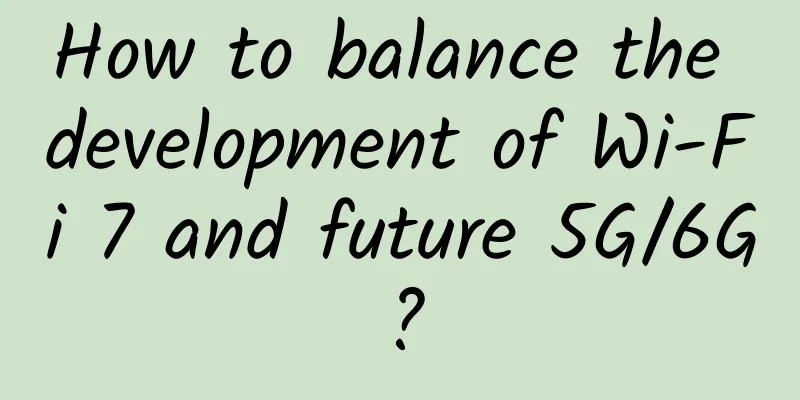Talk about the past and present of WiFi

|
When it comes to the development of WiFi, we have to mention two organizations: one is the Institute of Electrical and Electronics Engineers (IEEE) and the other is the WiFi Alliance. The full name of the Institute of Electrical and Electronics Engineers is: Institute of Electrical and Electronics Engineers, referred to as IEEE, which defines itself as "the world's largest technical professional association." IEEE is responsible for developing and maintaining the 802.11 wireless local area network (WLAN) communication standard, and is also maintaining more than 1,200 technologies and communication standards. WiFi Alliance (WFA) is a commercial alliance participated by many enterprises and organizations. It includes many companies, customers, operators and other organizations in the WiFi ecosystem. The purpose of the alliance is to jointly work on the use of standard-based wireless network technology to achieve and promote the development of open wireless communication technology. That is to say, IEEE is only responsible for writing and stipulating the standards of technical specifications that WiFi must comply with. These standards are published in the form of documents, but for manufacturers, it is impossible or impossible to integrate all specifications into products, which will lead to uneven product performance and indicators of various companies. The emergence of the WiFi Alliance is to develop test plans, services and certification plans for these extensive specifications to promote products to pass verification to meet the requirements of the specifications. By verifying the compatibility of products and providing the expected performance and functions, these products can establish trust in the market. As a standards organization, IEEE established the 802.11 working group in 1990 to develop relevant standards for wireless local area networks. Wireless Local Area Network (WLAN) has two meanings, broad and narrow. In a broad sense, WLAN is a network that uses various radio waves such as lasers, infrared rays and other wireless channels to replace part or all of the transmission media in wired local area networks; in a narrow sense, it is a wireless local area network based on the IEEE 802.11 series of standards, using high-frequency wireless radio frequencies such as radio electromagnetic waves in the 2.4GHz or 5GHz frequency band as the transmission medium. With the relatively simple implementation of WiFi technology, its advantages such as reliable communication, flexibility and low cost, it has gradually become the mainstream technical standard for wireless local area networks. WiFi has now become synonymous with WLAN technical standards. There are many 802.11 protocols. From 1997 to now, an average of more than 2 protocols have been released each year. This is a disaster for consumers - a meaningless combination of numbers and letters is difficult to remember. So the WiFi Alliance proposed a new naming system to make it easier for vendors to tell consumers which standards their devices support, service providers to explain what their networks provide, and users to understand which products use which standards. For example, the 802.11ax technology of the 6th generation of WiFi is called WiFi 6. WiFi 1/2/3/4/5/6 all correspond to a version of the protocol, indicating a major supplement to the protocol or the introduction of a new communication technology into the protocol. Features and disadvantages of each generation of WiFi:IEEE 802.11-1997:Features: The transmission rate reaches 1 Mb/s or 2 Mb/s, and three optional physical layer technologies are specified:
The latter two radio technologies use microwaves in the 2.4 GHz Industrial, Scientific, and Medical (ISM) band. The specified data rates are transmitted via infrared (IR) signals or via frequency hopping or direct sequence spread spectrum (DSSS) radio signals. IR transmission is part of the standard but is not actually implemented. Disadvantages: Poor interoperability due to too many transport options. IEEE 802.11b (WiFi 1):Features: Significantly increased speed: data rate is 11 Mbit/s. And the price has been significantly reduced. Disadvantages: It may cause interference with other products operating in the 2.4 GHz band, such as microwave ovens, cordless phones, and Bluetooth devices. IEEE 802.11a (WiFi 2):Features: The 5 GHz frequency band was included in the standard for the first time. It uses 52 subcarriers of Orthogonal Frequency Division Multiplexing (OFDM) technology, and the data rate is increased to 54 Mbit/s. It has good anti-interference performance. Disadvantages: The effective transmission range is slightly lower, and the penetration of 802.11a signals is not as good as 802.11b. 2.4G and 5G WiFi Comparison IEEE 802.11g (WiFi 3):Features: Works in the 2.4 GHz frequency band. Uses the same OFDM-based transmission method as 802.11a, with a maximum transmission rate of 54 Mbit/s. The hardware is fully backward compatible with 802.11b. Disadvantages: 2.4 GHz still has interference issues. If there are 802.11b devices on an 802.11g network, it will significantly slow down the speed of the entire 802.11g network. IEEE 802.11n (WiFi 4):Features: Utilizing MIMO multiple-input multiple-output technology and binding 40 MHz channels, channel bonding technology can bundle two adjacent frequency bands together for use, which can theoretically double the rate. In addition, the MAC layer adds a frame aggregation function. As a result, the single stream data rate is increased to a maximum of 600Mbps, which is 10 times higher than the rate of 802.11g. Disadvantages: The disadvantages of channel bundling technology are also obvious. Signals will interfere with each other and compete for spectrum resources. At the same time, when using a large bandwidth for transmission, it is necessary to ensure that all channels that need to be used are idle. Due to the existence of interference, it will retreat to a lower bandwidth, resulting in low channel utilization. IEEE 802.11ac (WiFi 5):Features:
Disadvantages: Due to the large differences in frequency allocation in the 5GHz band among countries, the availability and quantity of high-bandwidth channels vary, which will significantly increase the production complexity of equipment manufacturers selling globally. IEEE 802.11ax (WiFi 6):Features:
Disadvantages: The transmission distance of 802.11ax using the 5GHz frequency band is only half of that of the 2.4GHz signal. At the same time, the effective coverage range of 802.11ax signals is roughly the same as that of 802.11ac. With the popularization of smart terminals and the drive of new applications such as smart home, metaverse, virtual reality, and high-definition video, the performance requirements for wireless LANs are also increasing. Wireless networks need to provide users with a more extreme and faster experience, greater security, and more robust overall network performance - achieving automatic deployment, automatic optimization, and automatic troubleshooting. In the context of the Internet of Things, WiFi technology also faces competition from wireless transmission technologies such as NB-IoT, LoRa, and Zigbee. Compared with NB-IoT, LoRa and other technologies, WiFi technology is in a relatively high position in terms of indicators such as the number of access terminals, device power consumption, and the extent of price reduction. However, it has formed a good complement with the wide area network 5G technology. WiFi has improved the problems of poor penetration, low coverage, and high power consumption of 5G communication in indoor scenarios. 5G has also improved the problem that WiFi cannot achieve long-distance transmission of a large number of devices in outdoor scenarios. The complementary advantages of WiFi technology and wide area network technology are clearly in a long-term coexistence trend. |
<<: Let’s talk about the technological advances needed to realize the 6G vision
>>: Millimeter wave is imperative to unleash the full potential of 5G!
Recommend
Understanding Lossless Networks in One Article
According to OpenAI's data analysis, the amou...
Big data credit reporting system is the future development direction. Credit reporting helps the healthy development of the economy.
On December 5, the 4th International Forum on Int...
Watching B station can be faster!
[[384367]] This article is reprinted from the WeC...
The wave of data center upgrades is coming, and an excellent "trendsetter" needs to figure out these things!
[51CTO.com original article] In 2017, "digit...
In the "5G era", a large number of "unicorn" companies will emerge to seize the opportunity
Recently, Jiangsu Mobile Company released a messa...
CloudCone: $17.77/year KVM-512MB/100GB/3TB/Los Angeles MC Data Center
CloudCone's large hard disk VPS host is back ...
DogYun's fourth anniversary: 30% off on Elastic Cloud/20% off on Classic Cloud, 40% off on new Chongqing Cloud, 10 yuan free for every 100 yuan deposit, 100 yuan off for dedicated servers
Yesterday morning we shared information about Dog...
Eight data center technologies verified in 2015
2015 was a year in which new technologies matured...
Why enterprises should pay close attention to Wi-Fi 7
Industry experts predict that the latest Wi-Fi ve...
16 Useful Bandwidth Monitoring Tools to Analyze Network Usage in Linux
Why are today's networks so slow? Are you hav...
SD-WAN first or security first?
[[419685]] The right secure access service edge (...
Three steps to take before deploying SD-WAN
As enterprises develop their network strategies a...
Redis: How do I communicate with the client?
[[406813]] There is a saying in the martial arts ...
The digitalization journey of Hengshun
[[395022]] In 1840, during the reign of Emperor D...
Why is NB-IoT, which once "firmly sat" at the top of the low-power Internet of Things, now frequently "questioned"?
With the advent of the Internet of Things era, th...









